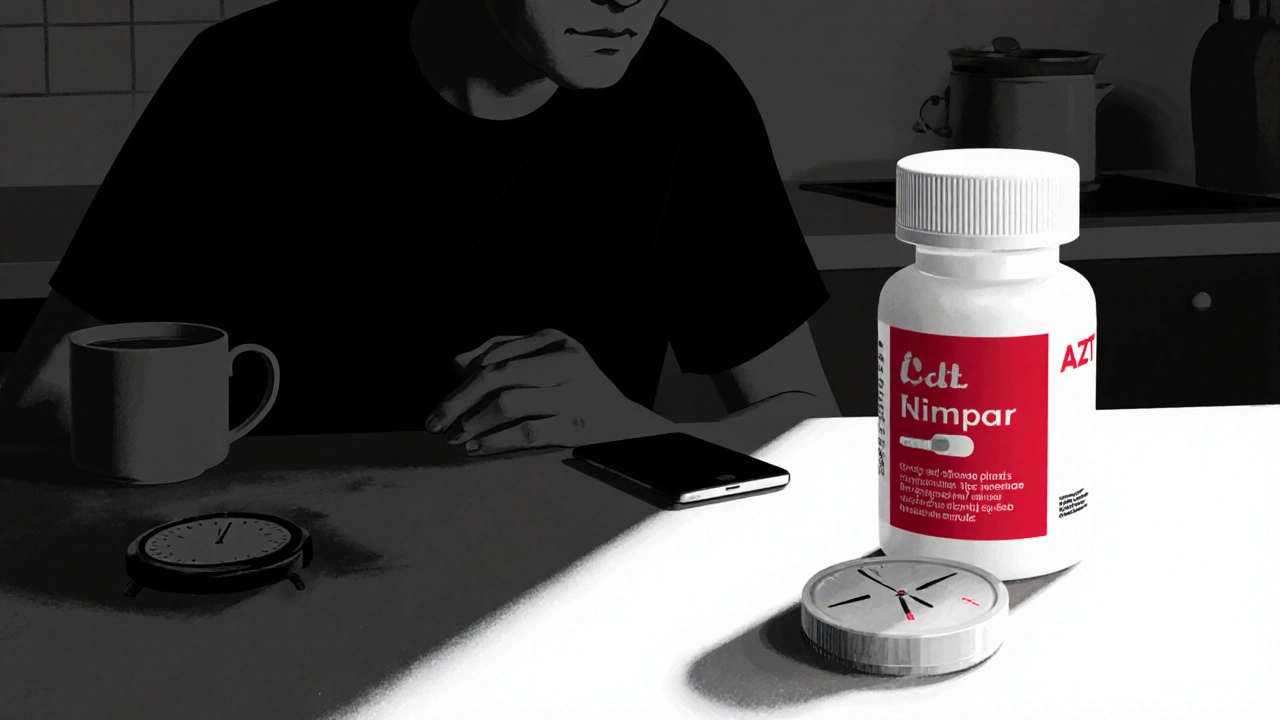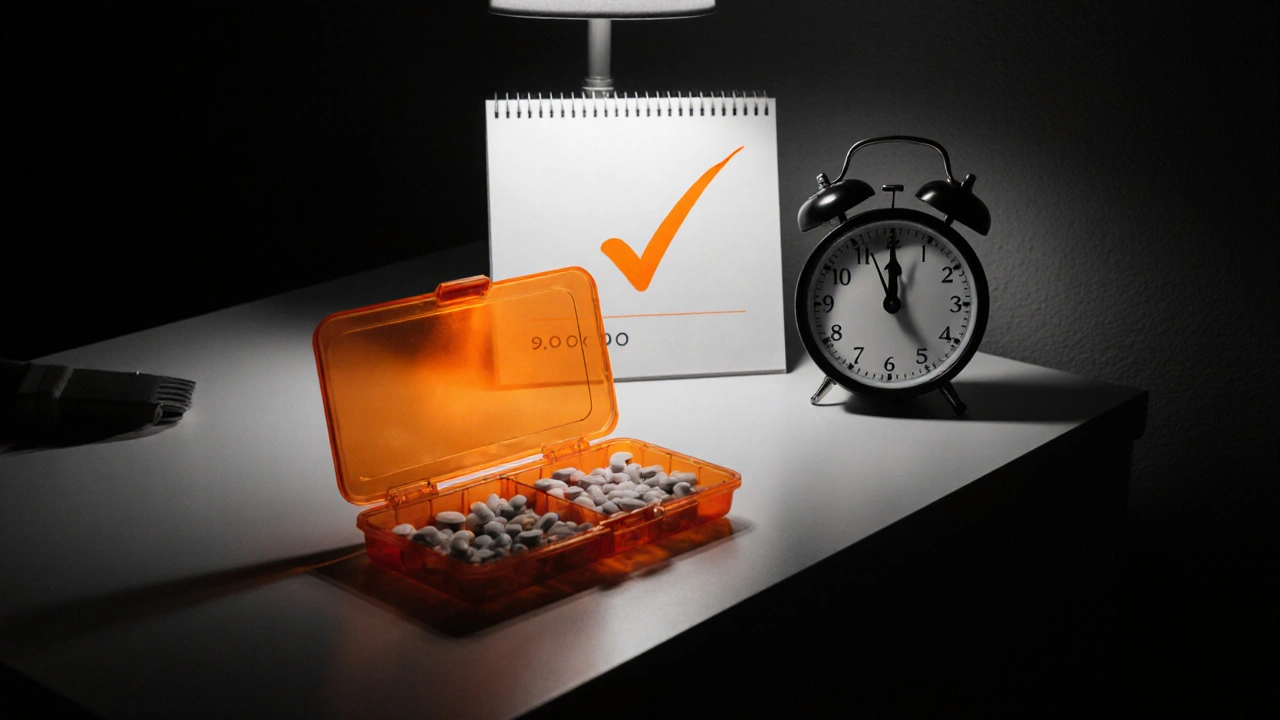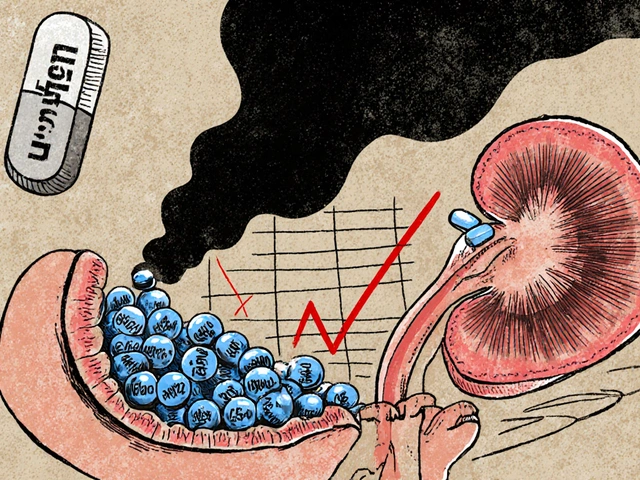
Zidovudine Adherence Tracker
Set Your Dose Schedule
Today's Doses
Adherence Summary
Finding the right medication after an HIV diagnosis can feel overwhelming. Zidovudine, often called AZT, is one of the first‑line drugs many doctors prescribe. This guide breaks down everything you need to know - from how the drug works to the daily routine that keeps the virus in check.
Quick Takeaways
- Zidovudine is a nucleoside reverse transcriptase inhibitor (NRTI) that blocks HIV replication.
- Typical adult dose is 300mg twice daily, adjusted for weight, kidney function, and pregnancy.
- Common side effects include mild anemia, nausea, and headache; serious issues are rare but need prompt medical attention.
- Regular blood tests (CBC, CD4 count, viral load) are essential to track effectiveness and safety.
- Adherence - taking every dose on schedule - dramatically reduces the risk of resistance.
Zidovudine is a nucleoside reverse transcriptase inhibitor (NRTI) used to treat HIV‑1 infection. It was the first antiretroviral drug approved by the FDA in 1987 and remains a cornerstone of many combination regimens.
When you’re newly diagnosed, the biggest question is often, “Will this drug work for me?” The short answer: yes, as long as you follow your doctor’s dosing plan and keep up with monitoring. Let’s walk through the details.
How Zidovudine Works
HIV replicates by inserting its genetic material into healthy cells. The virus relies on an enzyme called reverse transcriptase to turn its RNA into DNA - a step that lets it hijack the host cell. Zidovudine mimics the natural building block thymidine. When reverse transcriptase tries to use zidovudine, the drug gets incorporated into the viral DNA chain and halts further extension. In plain terms, it’s like replacing a link in a chain with a weak one that snaps under pressure.
This mechanism earns zidovudine the label NRTI. Because it targets a specific step in the virus’s life cycle, it works best when paired with other drugs that block different stages, forming a potent combination called antiretroviral therapy (ART).
Putting Zidovudine Into an ART Regimen
Modern guidelines recommend a three‑drug backbone: two NRTIs plus a third agent from a different class (like an integrase inhibitor). Zidovudine typically teams up with lamivudine (3TC) or abacavir (ABC). The third drug could be dolutegravir, bictegravir, or another agent that fits your health profile.
Why three drugs? Using multiple agents lowers the chance that HIV mutates into a resistant strain. Think of it as a lock with several tumblers - you need the right combination to open it.
Dosage Basics
For most adults, the standard dose is 300mg taken twice daily with food to reduce stomach upset. If you weigh less than 50kg, a reduced dose of 250mg twice daily may be prescribed. Kidney function matters, too: patients with a creatinine clearance below 30mL/min often need dose adjustments to avoid drug buildup.
Pregnant women can safely use zidovudine. Studies from the PACTG 076 trial showed that zidovudine reduces mother‑to‑child transmission by about 67%. The dose for pregnant patients is usually 300mg twice daily, but your obstetrician will tailor it based on your viral load.
What to Expect: Common Side Effects
Side effects are the most frequent reason people worry about starting a new medication. Here’s a snapshot of what you might feel in the first few weeks:
| Side Effect | Typical Onset | Severity |
|---|---|---|
| Nausea | First few days | Mild to moderate |
| Headache | First week | Usually mild |
| Fatigue | First two weeks | Variable |
| Anemia | Weeks to months | Moderate to severe |
| Neutropenia | 1‑2 months | Rare, monitor blood |
Most symptoms fade as your body adjusts. Eating a small snack before the dose often eases nausea, and staying hydrated can curb headaches.

Serious Risks and When to Call Your Provider
While rare, some side effects need immediate attention:
- Severe anemia (hemoglobin < 8g/dL) - you might feel dizzy, short of breath, or notice pale skin.
- Neutropenia (low white blood cell count) - higher infection risk, fever, or sore throat.
- Signs of liver toxicity - unusual yellowing of eyes or skin, dark urine.
If any of these appear, your doctor will likely pause the drug and run a complete blood count (CBC). Most issues resolve quickly once the dose is adjusted or a short break is taken.
Monitoring: What Labs Do You Need?
Regular lab work is the backbone of safe zidovudine therapy. Here’s a typical schedule for the first year:
- Baseline CBC, CD4 count, and HIV viral load before starting.
- Follow‑up CBC at 2 weeks, then monthly for the first three months.
- Viral load check at 4 weeks, then every 3‑6 months once suppressed.
- CD4 count every 6 months unless you have opportunistic infections.
During pregnancy, labs are done more frequently to ensure both mother and baby stay healthy.
Two key markers pop up often:
CD4 count measures immune strength - higher numbers mean your body can fight infections better. Viral load tracks the amount of HIV RNA in blood; the goal is < 50 copies/mL, which signals successful suppression.
Adherence: Making It Work Every Day
Missing doses is the #1 cause of drug resistance. Here are simple tricks that keep you on track:
- Set a phone alarm at the same times each day - morning and evening works for most schedules.
- Pair the pill with an established habit, like brushing teeth or having breakfast.
- Use a pill organizer with compartments for AM/PM - visual cues help you see quickly whether you’ve taken it.
- Keep a small stash in your bag or car for days you’re away from home.
If you ever forget a dose, take it as soon as you remember unless it’s almost time for the next one. In that case, skip the missed dose and continue with your regular schedule - double‑dosing can increase toxicity.
Drug Interactions to Watch
Zidovudine’s metabolism is relatively straightforward, but a few combos need attention:
- Didanosine (ddI) - concurrent use raises the risk of severe mitochondrial toxicity. Most clinicians avoid this pair.
- Lamivudine (3TC) - commonly co‑prescribed; no major issues, but dose adjustments may be needed for kidney problems.
- Alcohol - can worsen anemia and liver strain; moderation is key.
- Vaccines - live vaccines (e.g., yellow fever) should be avoided while your immune system is still stabilizing.
Always hand your full medication list to any new healthcare provider. A quick check can prevent unnecessary complications.

Special Populations: Kids, Seniors, and Co‑Infections
Children under 12 often receive weight‑based dosing (10mg/kg twice daily). Seniors may need closer monitoring for anemia, as age‑related decline in bone‑marrow function can amplify side effects.
If you’re living with hepatitis B or C, your doctor may choose a regimen that also targets those viruses. Zidovudine itself has limited activity against hepatitis B, so pairing it with tenofovir or entecavir is common.
When Zidovudine Isn’t the Right Choice
Though effective, zidovudine isn’t always first‑line for every patient. Reasons to consider alternatives include:
- History of severe anemia or bone‑marrow suppression.
- Concurrent use of didanosine or other drugs with overlapping toxicity.
- Desire for a once‑daily regimen - newer NRTIs like tenofovir alafenamide (TAF) offer that convenience.
If any of these apply, discuss options such as tenofovir, emtricitabine, or the newer integrase inhibitor‑based combos with your provider.
Bottom Line Checklist
- Take zidovudine exactly as prescribed - usually 300mg twice daily.
- Schedule regular labs: CBC, CD4 count, viral load.
- Watch for anemia signs - fatigue, shortness of breath, pale skin.
- Stay consistent with dosing times; use alarms or pill boxes.
- Inform every doctor about your zidovudine use, especially before surgeries or new prescriptions.
Frequently Asked Questions
Can I take zidovudine if I’m pregnant?
Yes. Clinical trials have shown that zidovudine reduces the risk of mother‑to‑child transmission. Your obstetrician will monitor viral load closely and may adjust the dose if needed.
How quickly will my viral load drop after starting zidovudine?
Most patients see a 1‑log (10‑fold) reduction within the first 4‑6 weeks when zidovudine is part of a full ART regimen. Full suppression (<50 copies/mL) often occurs within 3‑6 months.
What should I do if I miss a dose?
If it’s less than 12 hours late, take the missed dose right away. If it’s closer to the next scheduled dose, skip the missed one and continue as usual. Never double‑dose.
Is it safe to drink alcohol while on zidovudine?
Moderate drinking is generally okay, but heavy alcohol use can worsen anemia and liver stress. If you have a history of anemia, keep alcohol to a minimum.
Can zidovudine cause resistance?
Resistance can develop if the virus is exposed to sub‑therapeutic drug levels, typically from missed doses. That’s why strict adherence is crucial.
How often should I get blood work?
Initial CBC at baseline, then at 2 weeks, 1 month, and monthly for the first three months. After that, quarterly checks are common if labs stay stable.




Akshay Pure
October 15, 2025 AT 20:53The guide, while comprehensive, fails to address the socioeconomic barriers that many patients in developing regions encounter. A truly elite discussion would incorporate cost analysis and access disparity, which are conspicuously absent. Moreover, the emphasis on lab monitoring assumes a healthcare infrastructure that is far from universal. It also glosses over the psychological burden of daily dosing, an aspect that warrants deeper exploration. In short, the piece reads like a textbook for privileged clinics rather than a global handbook.
Steven Macy
October 16, 2025 AT 17:20While the concerns about accessibility are valid, the guide does a solid job outlining the core pharmacology and monitoring protocols. It offers a clear foundation that clinicians can adapt to varied settings. Awareness of cost and infrastructure issues is indeed essential, and perhaps future updates could integrate those perspectives. Nevertheless, the medical accuracy remains commendable, providing a useful starting point for patients navigating their treatment journey.
Matt Stone
October 17, 2025 AT 13:53Zidovudine works as expected but keep an eye on anemia.
Joy Luca
October 18, 2025 AT 10:26Zidovudine's pharmacokinetic profile, characterized by rapid absorption and intracellular phosphorylation, underscores its pivotal role in nucleoside analogue therapy.
Zidovudine‑triphosphate competes with natural deoxythymidine triphosphate for incorporation into viral DNA, causing chain termination; a classic mechanism validated across multiple in‑vitro models.
Clinicians must remain vigilant about hematologic toxicity, especially Grade 3–4 anemia that can emerge after several weeks of therapy.
Baseline CBC and monitoring at two‑week intervals during induction are non‑negotiable.
Renal clearance dictates dosing adjustments; patients with creatinine clearance below 30 mL/min often need a 20 % reduction to avoid accumulation.
Pregnant patients benefit from transplacental passage, reducing mother‑to‑child transmission by nearly two‑thirds, yet obstetric input remains essential for individualized dosing.
Drug–drug interactions are sparse, but co‑administration with didanosine has been linked to mitochondrial toxicity and should be avoided.
Alcohol consumption can exacerbate anemia, so moderation is advised as part of a holistic management plan.
Adherence strategies, such as integrating dosing with routine activities like brushing teeth, improve compliance rates by up to 30 %.
Pill organizers with AM/PM compartments provide visual reinforcement and reduce cognitive load.
If a dose is missed and more than two hours remain before the next scheduled dose, take the missed tablet; otherwise, skip and resume the regular schedule to avoid supra‑therapeutic peaks.
Insurance coverage variability can affect access; patient assistance programs are available through the manufacturer and should be explored early.
Overall, when embedded within a three‑drug ART regimen, zidovudine remains a cost‑effective backbone, particularly in resource‑limited settings.
Jessica Martins
October 19, 2025 AT 07:00The dosing schedule aligns with current DHHS recommendations. Patients should consult their providers for individualized adjustments based on weight and renal function.
Doug Farley
October 20, 2025 AT 03:33Oh great, another pill to add to the daily circus – just what we needed.
Jeremy Olson
October 21, 2025 AT 00:06While humor can alleviate stress, adherence remains paramount. Consistent dosing is the most reliable safeguard against resistance and treatment failure.
Ada Lusardi
October 21, 2025 AT 20:40Feeling nervous about side effects 😬? Remember you’re not alone 🌈 – many people manage them successfully with simple tricks like taking the pill with food.
Pam Mickelson
October 22, 2025 AT 17:13Your willingness to learn is commendable! Keep asking for clarity, and don’t hesitate to share your successes with the community.
Joe V
October 23, 2025 AT 13:46If you think a single NRTI is sufficient, you’re missing the point of combination therapy. A three‑drug backbone dramatically reduces the risk of resistance.
Scott Davis
October 24, 2025 AT 10:20Adherence beats everything.
Calvin Smith
October 25, 2025 AT 06:53Picture your immune system as a rebellious rock band-Zidovudine is the drummer keeping the rhythm steady, while the other meds play the guitars and bass.
Brenda Hampton
October 26, 2025 AT 02:26Stay proactive with your labs; each result is a checkpoint on your journey, helping you and your doctor fine‑tune the regimen for optimal health.
Lara A.
October 26, 2025 AT 23:00Did you know the pharma industry hides cheaper alternatives?? They don’t want us to know about the low‑cost generics that work just as well.
Ashishkumar Jain
October 27, 2025 AT 19:33I think the guide is good but maybe add some simple tips for newbie like us, like a quick checklist for the first week.